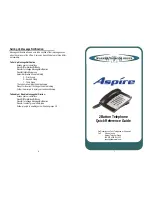
98 Appendix C: Consumer Update
2. Researchers conducted a large battery of laboratory tests
to assess the effect of exposure to mobile phone RF on
genetic material. These included tests for several kinds of
abnormalities, including mutations, chromosomal
aberrations, DNA strand breaks, and structural changes in
the genetic material of blood cells called lymphocytes.
None of the tests showed any effect from the RF except for
the micronucleus assay, which detects structural effects on
the genetic material. The cells in this assay showed
changes after exposure to simulated cell phone radiation,
but only after 24 hours of exposure. It is possible that
exposing the test cells to radiation for this long resulted in
heating. Since this assay is known to be sensitive to
heating, heat alone could have caused the abnormalities to
occur. The data already in the literature on the response of
the micronucleus assay to RF are conflicting. Thus, follow-
up research is necessary.
2
FDA is currently working with government,
industry, and academic groups to ensure the
proper follow-up to these industry-funded
research findings. Collaboration with the Cellular
Telecommunications Industry Association (CTIA)
in particular is expected to lead to FDA providing
research recommendations and scientific
oversight of new CTIA-funded research based on
such recommendations.
Two other studies of interest have been reported
recently in the literature:
1. Two groups of 18 people were exposed to simulated
mobile phone signals under laboratory conditions while
they performed cognitive function test. There were no
changes in the subjects’ ability to recall words, numbers, or
pictures, or in their spatial memory, but they were able to
make choices more quickly in one visual test when they
were exposed to simulated mobile phone signals. This was
the only change noted among more than 20 variables
compared.
3
2. In study of 209 brain tumor cases and 425 matched
controls, there was no increased risk of brain tumors
associated with mobile phone use. When tumors did exist
in certain locations, however, they were more likely to be
on the side of the head where the mobile phone was used.
Because this occurred in only a small number of cases, the
increased likelihood was too small to be statistically
significant.
4
In summary, we do not have enough information
at this point to assure the public that there are, or
are not, any low incident health problems
associated with use of mobile phones. FDA
continues to work with all parties, including other
federal agencies and industry, to assure that
research is undertaken to provide the necessary
answers to the outstanding questions about the
safety of mobile phones.
What is known about cases of human
cancer that have been reported in users of
handheld mobile phones?
Some people who have used mobile phones
have been diagnosed with brain cancer. But it is
important to understand that this type of cancer
also occurs among people who have not used
mobile phones. In fact, brain cancer occurs in the
U.S. population at a rate of about 6 new cases
per 100,000 people each year. At that rate,
assuming 80 million users of mobile phones (a
number increasing at a rate of about 1 million per
month), about 4800 cases of brain cancer would
be expected each year among those 80 million
people, whether or not they used their phones.
Thus it is not possible to tell whether any
individual’s cancer arose because of the phone,
or whether it would have happened anyway. A
key question is whether the risk of getting a
particular form of cancer is greater among people
who use mobile phones than among the rest of
the population. One way to answer that question
is to compare the usage of mobile phones among
people with brain cancer with the use of mobile
phones among appropriately matched people
without brain cancer. This is called a case-control
study. The current case-control study of brain
cancers by the National Cancer Institute, as well
as the follow-up research to be sponsored by
industry, will begin to generate this type of
information.
What is FDA’s role concerning the safety of
mobile phones?
Under the law, FDA does not review the safety of
radiation-emitting consumer products such as
mobile phones before marketing, as it does with
new drugs or medical devices. However, the
agency has authority to take action if mobile
phones are shown to emit radiation at a level that
is hazardous to the user. In such a case, FDA
could require the manufacturers of mobile phones
to notify users of the health hazard and to repair,
replace or recall the phones so that the hazard no
longer exists.
Although the existing scientific data do not justify
FDA regulatory actions at this time, FDA has
urged the mobile phone industry to take a number
of steps to assure public safety. The agency has
recommended that the industry:
• support needed research into possible
biological effects of RF of the type emitted by
mobile phones;
• design mobile phones in a way that minimizes
any RF exposure to the user that is not
necessary for device function; and
Содержание GU87
Страница 1: ......
Страница 2: ......
Страница 44: ...40 Games Menu ...
Страница 106: ...102 Appendix E Server Profile ...
Страница 111: ......
Страница 112: ......











































